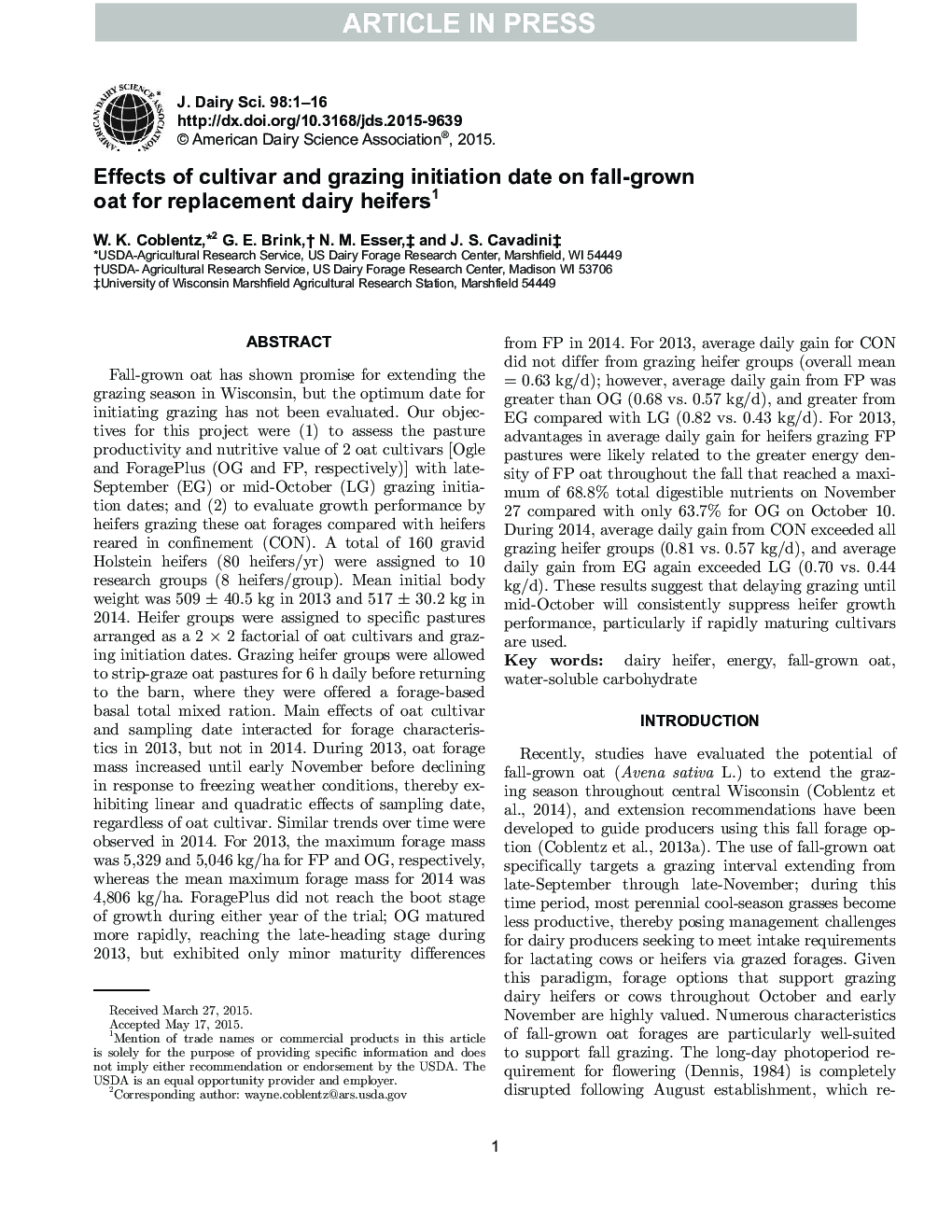| کد مقاله | کد نشریه | سال انتشار | مقاله انگلیسی | نسخه تمام متن |
|---|---|---|---|---|
| 10974358 | 1108024 | 2015 | 16 صفحه PDF | دانلود رایگان |
عنوان انگلیسی مقاله ISI
Effects of cultivar and grazing initiation date on fall-grown oat for replacement dairy heifers1
ترجمه فارسی عنوان
تأثیر رقم و تاریخ شروع قاچاق در جوجه سقوط شده برای تلیسه های جایگزین شیری 1
دانلود مقاله + سفارش ترجمه
دانلود مقاله ISI انگلیسی
رایگان برای ایرانیان
کلمات کلیدی
تلیسه لبنیات، انرژی، جو دوسر سقوط کربوهیدرات محلول در آب،
موضوعات مرتبط
علوم زیستی و بیوفناوری
علوم کشاورزی و بیولوژیک
علوم دامی و جانورشناسی
چکیده انگلیسی
Fall-grown oat has shown promise for extending the grazing season in Wisconsin, but the optimum date for initiating grazing has not been evaluated. Our objectives for this project were (1) to assess the pasture productivity and nutritive value of 2 oat cultivars [Ogle and ForagePlus (OG and FP, respectively)] with late-September (EG) or mid-October (LG) grazing initiation dates; and (2) to evaluate growth performance by heifers grazing these oat forages compared with heifers reared in confinement (CON). A total of 160 gravid Holstein heifers (80 heifers/yr) were assigned to 10 research groups (8 heifers/group). Mean initial body weight was 509 ± 40.5 kg in 2013 and 517 ± 30.2 kg in 2014. Heifer groups were assigned to specific pastures arranged as a 2 Ã 2 factorial of oat cultivars and grazing initiation dates. Grazing heifer groups were allowed to strip-graze oat pastures for 6 h daily before returning to the barn, where they were offered a forage-based basal total mixed ration. Main effects of oat cultivar and sampling date interacted for forage characteristics in 2013, but not in 2014. During 2013, oat forage mass increased until early November before declining in response to freezing weather conditions, thereby exhibiting linear and quadratic effects of sampling date, regardless of oat cultivar. Similar trends over time were observed in 2014. For 2013, the maximum forage mass was 5,329 and 5,046 kg/ha for FP and OG, respectively, whereas the mean maximum forage mass for 2014 was 4,806 kg/ha. ForagePlus did not reach the boot stage of growth during either year of the trial; OG matured more rapidly, reaching the late-heading stage during 2013, but exhibited only minor maturity differences from FP in 2014. For 2013, average daily gain for CON did not differ from grazing heifer groups (overall mean = 0.63 kg/d); however, average daily gain from FP was greater than OG (0.68 vs. 0.57 kg/d), and greater from EG compared with LG (0.82 vs. 0.43 kg/d). For 2013, advantages in average daily gain for heifers grazing FP pastures were likely related to the greater energy density of FP oat throughout the fall that reached a maximum of 68.8% total digestible nutrients on November 27 compared with only 63.7% for OG on October 10. During 2014, average daily gain from CON exceeded all grazing heifer groups (0.81 vs. 0.57 kg/d), and average daily gain from EG again exceeded LG (0.70 vs. 0.44 kg/d). These results suggest that delaying grazing until mid-October will consistently suppress heifer growth performance, particularly if rapidly maturing cultivars are used.
ناشر
Database: Elsevier - ScienceDirect (ساینس دایرکت)
Journal: Journal of Dairy Science - Volume 98, Issue 9, September 2015, Pages 6455-6470
Journal: Journal of Dairy Science - Volume 98, Issue 9, September 2015, Pages 6455-6470
نویسندگان
W.K. Coblentz, G.E. Brink, N.M. Esser, J.S. Cavadini,
